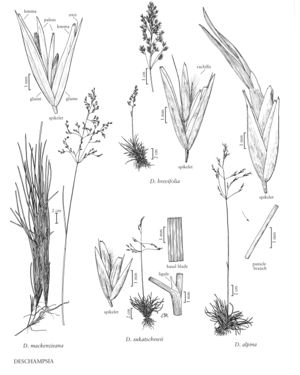Deschampsia brevifolia
Plants perennial; cespitose, not glaucous. Culms 5-55 cm, erect, glabrous. Leaves often forming a basal tuft; sheaths glabrous; ligules 1-4.5 mm, acute or acuminate, entire; blades 2-12 (16) cm long, usually 0.3-0.8 mm in diameter, folded or convolute, 0.5-2 mm wide when flat, abaxial surfaces glabrous, adaxial surfaces glabrous or sparsely hirtellous, sometimes scabrous, blades of flag leaves 0.8-3 cm. Panicles 1.5-10 (12) cm long, 0.5-2 (11) cm wide, usually dense, oblong-ovate to narrowly cylindrical; branches 1-3.6 (6) cm, straight, usually stiff, erect to ascending, usually smooth or almost so, scabrules separated by 0.2+ mm, spikelet-bearing to near the base. Spikelets 2.3-6 mm, ovate to obovate, with 2 (3) florets. Glumes subequal to equal, 2.5-5.6 mm, purplish over more than 1/2 their surface, lanceolate, smooth, acuminate or acute; lower glumes 1-veined, smooth; upper glumes exceeding to exceeded by the lowest floret, 3-veined; callus hairs 0.2-2 mm; lemmas 2.2-4 mm, oblong or lanceolate, smooth, shiny, glabrous, awns (0.2) 0.7-4 mm, usually equaling or exceeding the lemmas, straight or weakly geniculate, usually attached from near the base to midlength, occasionally connate almost their full length; anthers 1.2-2.5 mm. 2n = 26, 27, 28, about 50, 52.
Distribution
Alaska, Greenland, Nfld. and Labr. (Nfld.), N.W.T., Nunavut, Que., Yukon
Discussion
Deschampsia brevifolia is a circumboreal taxon that grows in wet places in the tundra, often in disturbed soils associated with riverbanks, frost-heaving, etc. It is interpreted here as extending southward through the Rocky Mountains to Colorado, where it grows at elevations up to 4300 m. It is to be expected from high elevations in British Columbia and Alberta; specimens currently identified as D. cespitosa, in which D. brevifolia is often included as a subspecies, need to be examined.
In its typical appearance, Deschampsia brevifolia is quite distinctive because of its dark, narrow panicles. Culm height can vary substantially from year to year, probably in response to the environment. Aiken et al. (1995 on) reported that plants transplanted from Eureka Sound, Ellesmere Island (80° 9' N 86° 0' W) to Iqaluit, Baffin Island (64° 44' N 68° 28' W) became smaller and more stunted; most of those transplanted to Ottawa, Ontario (45° 18' N 75° 50' W) died, but some grew larger than at the original site, and developed more diffuse panicles.
Selected References
None.
Lower Taxa
"wide" is not a number."decumbent" is not a number.
